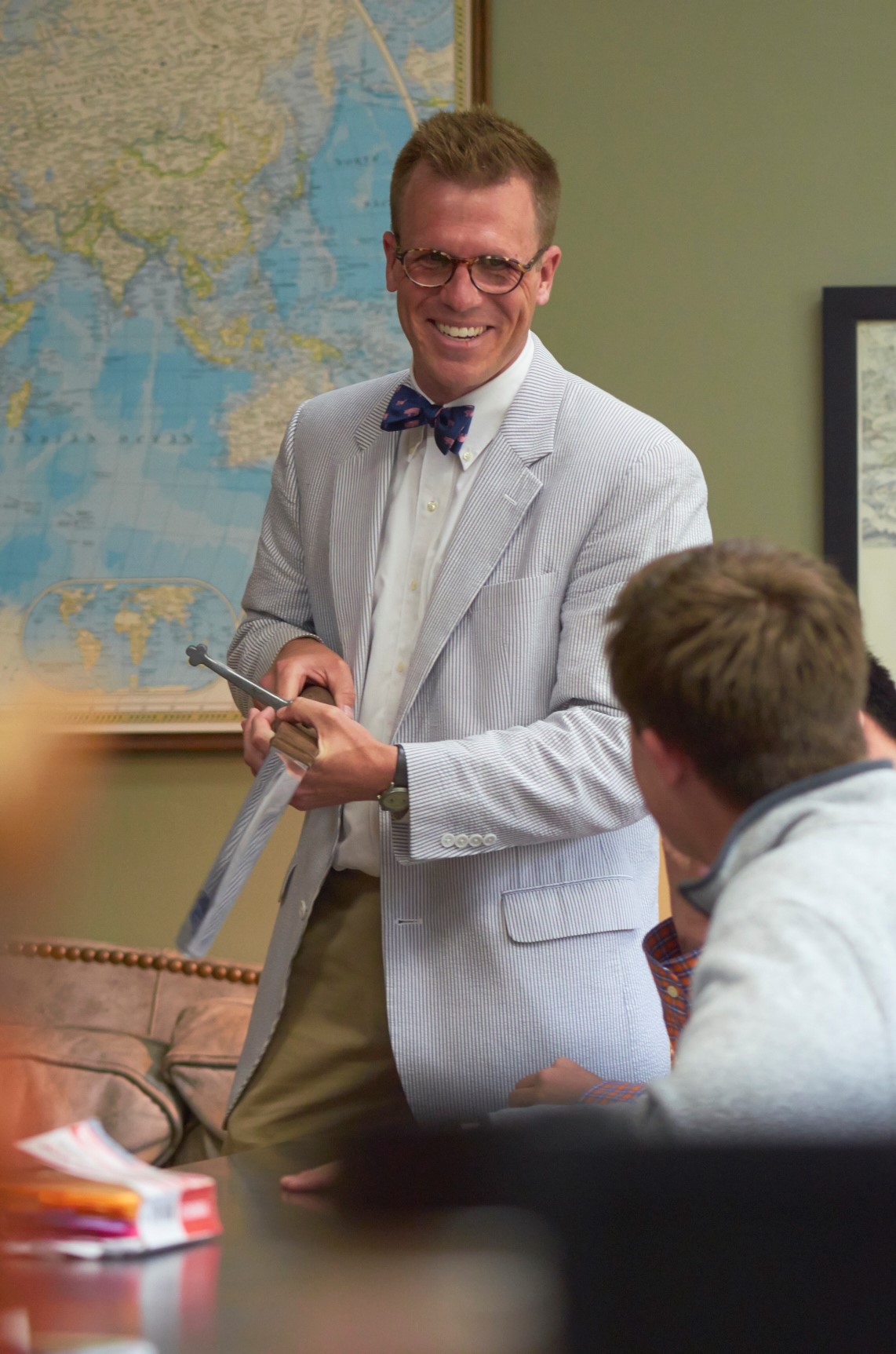Brent Kaneft
Teachers Use Social Media to Their Advantage
New approaches to learning, teaching at Christ School
Note: English Department chair Brent Kaneft polled Christ School faculty members to find out how they integrate social media into the classroom. Kaneft also wrote about his own experiences from a first person perspective in this article:
When I came to Christ School eight years ago, I never thought I would create an account on a social media platform. In fact, at every turn, I disparaged its use by students and faculty alike. You could hear me from down the hallway: "Don't be a slave to technology, boys!" But I've changed my mind about social media.
My fears about social media check the usual boxes: social media distracts us from the present moment; it tricks us into, as (History Department chair) Ben Dowling has said, confusing what's important with what's viral; and it monopolizes our time. But to reject social media outright is like trying to stop a wave with your hands, both impossible and futile. Social media is here to stay; we must learn how to ride its wave because staying on the beach when all of our students are in the water is not a luxury any teacher can afford.
These platforms - Facebook, Twitter, Instagram, and Snapchat - are shaping our social relations whether we like it or not. As teachers, we should always be willing to consider new possibilities, like,
- What if social media can help me attain my course goals?
- Can social media connect students to communities interested in my subject?
- Will my involvement with social media inspire students to use these platforms to improve learning, increase participation in the world around them, and receive feedback from a unique audience?
In her new book, Braving the Wilderness, social scientist Brené Brown says "the way we engage with social media is like fire — [we] can use them to keep [ourselves] warm and nourished, or [we] can burn down the barn." Later, Brown quotes Susan Pinker, a well-known researcher in this area, from her book, The Village Effect: How Face-to-Face Contact Can Make Us Healthier and Happier: "In-person interactions," Pinker says, "are proven to bolster our immune system, send positive hormones surging through our bloodstream and brain, and help us live longer." So there is a balance at play. Social media can be a powerful tool that helps students keep "warm and nourished" by the fires teachers are lighting in their classrooms. But, it is our responsibility as a learning community to insist on those "in-person interactions."
Here are a few ways Christ School teachers are using social media to advance learning and increase student engagement:
1. Finding New Audiences: Marcel Duhaime, our Engineering teacher, uses Twitter and Instagram to show off his student's work. "Knowing that someone else besides me will see their work," Duhaime says, "has motivated them to create some very impressive products." Marcel hits on one of the biggest arguments for using social media in the classroom: it creates a new audience for students. When your teacher (i.e. lame adult) is the only one to see your work, often students don't put their best foot forward, but when they know there is a broader audience, their engagement improves.
Although she doesn't always use social media in her courses, Sarah Baldwin, our Art Director, had some great things to say about its use in her Advanced Art class: "In Advanced Art, I encourage my students to not only make a website/digital portfolio, but to also create an Instagram specifically for their artwork so that we can follow and support one another's artistic endeavors. They are then encouraged to link their Instagram to their website and likewise. I talk about personal branding and marketing, and even encourage students to follow/tag/DM/hashtag professional artists, art galleries, and museums in order to connect with these various art organizations and build a following. I think it's necessary for young artists to discover their niche audience and learn how to successfully market their work; it's an important part of being a full-time artist, and it's the difference between a financially successful artist and a 'starving artist.' Considering that my personal art Instagram is public, I allow and encourage students to follow me so that they can see my artwork and personal style. It creates a unique dialogue about pursuing an arts-based career as well as developing a cohesive body of work. I also think it helps to humanize me; instead of me always observing my students work, it gives them a chance to observe and critique my work."
Sarah hits on a great point: social media allows students to see our work, too. For the first time ever, I am requiring my students to write blog posts. The exercise has been beneficial so far. One, it is open-ended, so those student complaints about not getting to write about what interests them are silenced. It's a weekly exercise, too, so I am getting students to write more. Blog posts (after they are corrected and vetted through me) are posted for a broader audience. And finally, to Sarah's point, I write them as well, so students get to see and critique my work after I post those blogs on my Twitter account.
2. Extending Their Classrooms: Olga Mahoney uses Twitter as a way "to keep the topic of World History alive and active outside of classroom time." She posts news articles, interesting facts, and critical questions on her account, so students continue their discussions offline with their peers. They can also post short reflections about class topics. There are other ways of doing this, of course. Our OnCampus learning management system has a discussion option, and many of our teachers use it. Social media is a tool in the toolbox, an option for teachers who want it.
3. Promoting Creativity: As an English teacher, I am inspired by how my colleague, Kyle Fraser, uses Twitter for his final project in World Literature: "My 10th grade sections of World Literature, 'The Art of Storytelling,' focus on showing the students just how important stories are to humanity. The next step is to then use a variety of a texts to demonstrate how different communities' and cultures' stories can reveal so much about what they respectively value. The goal of the end of the year 'Twitter Project' is to encourage the students to highlight what they value by using a medium, Twitter, that is familiar to them. This year I will have each student write his own short story first. There will of course be some guiding parameters; they will have to work within the literary frameworks of either 'Magical Realism' or the 'Bildungsroman,' but they'll have a lot of freedom in the subject matter of the story itself. They will later be split up into groups, and they'll have to make the tough decision of figuring out whose story will be used for the project. This will most likely be the one that is either the most appealing or the easiest to transfer into the "Twittersphere." I'm fine with either of these options; the first highlights the work of another student, while the latter shows that they can identify how different literary mediums can work. The last part of this process is centered around group work. The students must first tailor their chosen story so that it works for Twitter. Each student in the group will take on a different role: one producer, one writer, and one developer. They are allowed to divvy up responsibilities at their discretion. The final product will be a series of tweets in which the fictional characters of each story, who are consequently represented by fictitious Twitter accounts, converse with one another. Each story will have one narrator to help drive home the plot. It's important to note that the majority of each story will be dialogue. It's my opinion as a writer that you can reveal most of what you need to through conversation, so I'm fine with this form of storytelling. I tell them— if you can capture the voice, then you can capture the scene and consequently the reader as well."
4. Improving Skills: In her more advanced classes, Vanessa Giuliani, chair of the Language Department, will "encourage students to use Spanish in a 'real life' context (i.e. social media)." Advanced students "create a new tweet each week incorporating either new vocabulary or the grammatical topic of the week. For example, when we studied clothing, students could tweet about "Los nuevos zapatos de Steph Curry."
Each week I require my students to write a "Twitter Story," which is a true story in one tweet (130 characters after you add the hashtag). I decide on the best one from each section and retweet them so all of my students can read the winners. The best part of this exercise is that because of its limited space, students have to work on word choice, punctuation, and syntax, all skills that help them develop as writers. Both of these exercises, along with the others, show how social media can be used to improve skills, advance learning, and increase student engagement.






